List of English flags
This is a list of English flags, including symbolic national and sub-national flags, standards and banners used exclusively in England. The College of Arms is the authority on the flying of flags in England and maintains the only official register of flags. It was established in 1484 and as part of the Royal Household operates under the authority of The Crown.[1] A separate private body called the Flag Institute, financed by its own membership, also maintains a registry of United Kingdom flags that it styles 'the UK Flag Registry', though this has no official status under English law.[2]

Certain classes of flag enjoy a special status within English planning law and can be flown without needing planning permission as advertisements. These include any country’s national flag, civil ensign or civil air ensign; the flag of the Commonwealth, the European Union, the United Nations or any other international organisation of which the United Kingdom is a member; a flag of any island, county, district, borough, burgh, parish, city, town or village within the United Kingdom; the flag of the Black Country, East Anglia, Wessex, any Part of Lincolnshire, any Riding of Yorkshire or any historic county within the United Kingdom; the flag of St David; the flag of St Patrick; the flag of any administrative area within any country outside the United Kingdom; any flag of Her Majesty’s Forces; and the Armed Forces Day flag.[3]
National Flag
| Flag | Date | Use | Description |
|---|---|---|---|
 | 1417 - Present | Flag of England (also known as the St George's Cross) | A centred red cross on a white background, 3:5.[4] |
Royal Banner
| Flag | Date | Use | Description |
|---|---|---|---|
 | circa 1200 | Royal Banner of England | Three gold lions (or leopards) passant on a red field. The Royal Banner of England is based on the Royal arms of England. The banner is neither a national flag or a royal standard, and only represents the ruling monarch exclusively in England. The Banner of England is included within the current Royal Standard, along with heraldic devices from the other constituent parts of the United Kingdom. |
Royal Standards
| Flag | Date | Use | Description |
|---|---|---|---|
 | 1837 | Royal Standard of the United Kingdom. It is the banner of Queen Elizabeth II in her capacity as Queen of the United Kingdom. | Split into quarters, the first and fourth quarters contain three gold lions passant on a red field (representing England and Wales); the second quarter contains a red lion rampant on a gold field (representing Scotland); the third quarter contains a gold harp on a blue field (representing Ireland). |
 | 1509–1547 | Royal Standard of King Henry VIII | Between 1405 and 1603 the Royal Arms of England were Quarterly, France Modern and England: that is, three fleurs-de-lis in the 1st and 4th quarters, and three lions passant guardant in the 2nd and 3rd quarters.[5] |
 | Before 1695 | Standard of the Duchy of Cornwall | 15 golden dots forming a triangle on a black field |
 | Standard of the Duchy of Lancaster | The Royal Banner of England, with a three-point label, each containing three fleurs-de-lis | |
.svg.png.webp) | 1305 | Standard of the Lord Warden of the Cinque Ports | A banner of the Lord's coat of arms, featuring three lions passant guardant conjoined to three hulls, all in gold |
Government
| Flag | Date | Use | Description |
|---|---|---|---|
 | 1829 | Flag of the Greater London Metropolitan Police | The Badge of the Metropolitan Police on a blue background, with white squares at the edge |
Church
| Flag | Date | Use | Description |
|---|---|---|---|
 | 1954 | Flag of the Anglican Communion | A dark blue background with the symbol of the Anglican Communion (a compass rose surmounted by a bishop's mitre; in the centre is a cross of St George). The Greek motto, Ἡ ἀλήθεια ἐλευθερώσει ὑμᾶς ("The truth will set you free") is a quotation from John 8:32. |
 | Flag of Westminster Abbey | Tudor arms between Tudor roses, above arms attributed to Edward the Confessor |
Historic counties
Of the 39 historic counties, 38 have flags registered with the Flag Institute, with only Leicestershire outstanding, as of 3 November 2019. Some flags are traditional, meaning their designs have long been associated with the county (or in some cases, such as Kent and Sussex, an ancient kingdom), while other flags are based on the County Council arms or are winners of recent design competitions. The dates indicate the flag's date of first appearance, description, or in more recent examples, its registration with the Flag Institute.
| Flag | Date | Use | Description |
|---|---|---|---|
 | Traditional; 12 April 1951 | Flag of Bedfordshire reg coa | Traditional county flag. The red and yellow colours come from the Beauchamps family coat of arms. The vertical black stripe with three shells, or escallops, comes from the arms of the Dukes of Bedford. The wavy lines represent the River Great Ouse. A slightly updated version was registered with the Flag Institute on 14 September 2014 after Bedfordshire County Council was disbanded and replaced by two unitary authorities. |
 | Traditional; 2 March 2017 | Flag of Berkshire reg | Traditional badge: a stag beneath Herne the Hunter's oak. |
 | Traditional; 20 May 2011 | Flag of Buckinghamshirereg | Traditional county flag. A field party per pale of black and red with a white swan. |
 | 1 February 2015 | Flag of Cambridgeshirereg | The three gold crowns represent East Anglia, with wavy light blue lines representing the river Cam in the colours of Cambridge University on a dark blue background. |
|
| 3 May 1938 | Flag of Cheshire | Three golden sheaves of wheat and a golden blade on a blue background. The design has been associated with the Earldom of Chester since the 12th century, and has been used in the coat of arms of Chester since at least 1560. |
 | 1838 | Saint Piran's Flag, the Flag of Cornwallreg | A white cross on a black field, 3:5.[6] |
 | 19 September 1950 | Flag of Cumberland | Design based on the arms of the former Cumberland County Council.[7] |
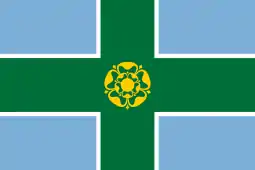 | 22 September 2006 | Flag of Derbyshirereg | A green cross with a white border on a sky blue field, with a gold Tudor rose in the centre, 3:5.[8] |
 | 23 July 2006 | Flag of Devon, alias St Petroc's Crossreg | A white cross with a black border on a green field, 3:5.[9] |
 | 16 September 2008 | Flag of Dorset – The Dorset Cross, aka St Wite's Crossreg | A white cross with a red border on a gold field, 3:5.[10] |
 | 21 November 2013 | Flag of County Durham | A gold and blue horizontal bicolour with St Cuthbert's Cross countercharged upon it, 3:5.[11] |
 | Ancient | Flag of Essexreg | A red field with three white, gold hilted seax (Saxon swords).[12] |
 | March 2008 | Flag of Gloucestershire – The Severn Crossreg | A mid-blue cross, outlined in cream, against an apple green background – the winning entry in a competition to commemorate the county's millennium.[13] |
 | 12 March 2019 | Flag of Hampshirereg | A gold Saxon crown above a Tudor rose over a field of red and gold representing the former Saxon kingdom of Wessex. |
 | 2 November 2019 | Flag of Herefordshirereg | On a dark red background, a white bull's head above three wavy lines, ordered white-blue-white.[14] |
 | 19 November 2008 | Flag of Hertfordshirereg coa | Against eight blue and white wavy lines, representing the county's rivers, a gold shield bearing a resting deer or hart.[15] |
 | 25 June 2009 | Flag of Huntingdonshirereg | On a green background, a gold, ribboned hunting horn – a flag displayed on the crest of the district council (and former county council) arms |
 | 1605 | Flag of Kent reg | A red field with a white horse in the centre, 3:5.[16] |
 | Modern form since 20 November 2008 | Flag of Lancashire reg | The Red Rose of Lancashire on a yellow field (originally a white field).[17][18] |
| Flag of Leicestershire | None | ||
 | 24 October 2005 | Flag of Lincolnshirereg | A red cross with yellow trimming on a blue and green field, and a yellow fleur de lys in the middle of the cross.[19] |
 | 1909 | Flag of Middlesex reg | A red field with three white, gold-hilted Saxon swords or seax under a gold Saxon crown.[20] |
 | 11 September 2014 | Flag of Norfolk reg | Ermine bend from top left to bottom right on a gold and black field.[21] |
 | 11 September 2014 | Flag of Northamptonshirereg | A gold cross with a black border on a maroon field with a rose in the centre.[22] |
 | 7th century (modern form 1951) | Flag of Northumberland reg coa | Historical flag readopted in 1951 and used officially by the county council, and later released by the council and registered as the flag of the historic county. Eight yellow rectangles on a red field; note that the canton (top corner nearest the flagpole) should be gold.[23] |
 | 20 May 2011 | Flag of Nottinghamshire reg | The inescutcheon represents Robin Hood. |
 | 2017 on | Flag of Oxfordshire | The arms of the pre-1974 County Council: blue with a red ox head on a double bend wavy, between a wheatsheaf and an oak. (Registered by the Flag Institute)[24] |
 | 17 November 2015 | Flag of Rutland reg coa | A green field semée of acorns with a golden horseshoe in the centre |
 | March 2012 | Flag of Shropshire reg | The leopards' faces, fondly referred to as "loggerheads" locally, are a traditional emblem for Shropshire and have historically evolved from the loggerheads on the Shrewsbury town arms. The erminois aspect differentiates the county flag from that of its county town. |
 | 4 July 2013 | Flag of Somerset reg | A red dragon rampant on a gold field, from a longstanding local badge; the winning entry in a competition. |
 | 28 March 2016 | Flag of Staffordshire reg | A red chevron on a gold field, with a gold Stafford knot, the county's longstanding symbol. All elements are taken from the de Stafford coat of arms. Designed by the Staffordshire Heritage Group and chosen by the Flag Institute over the county council's own flag after a public vote.[25] |
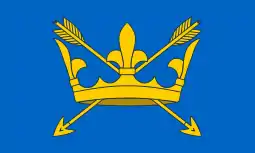 | 9 October 2017 | Flag of Suffolk reg | Derived from the arms attributed to Saint Edmund the Martyr.[26] |
 | 11 September 2014 | Flag of Surrey reg | Chequey Or and azure; a traditional design derived from a personal coat of arms first recorded in the 11th century.[27] |
 | 20 May 2011 | Flag of Sussex reg | Six gold martlets on blue are the traditional emblem of Sussex.[28] This flag is for public use by the entire shire county of Sussex and its people.[29] |
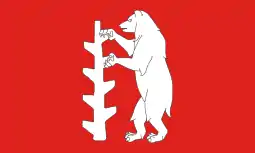 | 15 August 2016 | Flag of Warwickshire reg | The traditional bear and ragged staff badge, shown white on red; the badge is from that of the Earls of Warwick. |
 | 30 September 2011 | Flag of Westmorland reg | A golden heraldic apple tree on white and red bars |
 | 5 June 2007 | Flag of Wiltshire reg | Alternating stripes of green and white represent the grassy downs of the county and their chalk underlay. The colours can represent hope, joy and safety (green) and peace (white). In the centre, the male great bustard is depicted in gold on a solid green circle to represent the open grassland. The circle is bordered in six sections alternating green and white, representing the stone circles of Stonehenge and Avebury in the county. The six portions also represent the six surrounding counties of Gloucestershire, Oxfordshire, Berkshire, Hampshire, Dorset and Somerset. |
 | 8 April 2013 | Flag of Worcestershire reg | Black pears appear in the arms of the City of Worcester, and as such have long been considered a county badge, reportedly dating back to the Battle of Agincourt. The county flag was established by a competition in 2013.[30] |
 | 1965 or earlier | Flag of Yorkshire reg | The White Rose of York (the traditional county emblem) on a blue field.[31] |
Ceremonial counties
The counties and areas for the purposes of the lieutenancies, also referred to as the lieutenancy areas of England[32] and informally known as ceremonial counties,[33] are areas of England to which lords-lieutenant are appointed. Legally, the areas in England, as well as in Wales and Scotland, are defined by the Lieutenancies Act 1997 as "counties and areas for the purposes of the lieutenancies in Great Britain", in contrast to the areas used for local government. They are also informally known as "geographic counties",[34] to distinguish them from other types of counties of England.
| Flag | Date | Use | Description |
|---|---|---|---|
 | 1381 | Flag of the City of London (Ceremonial county and city flag) | A red cross on a white field, with a red sword in the canton. The City of London (excluding Greater London) is England's smallest county and measures approximately 1 square mile (2.6 km2). The City of London is officially not one of Greater London's 32 borough's. |
 | January 2009 | Flag of the Isle of Wight reg | A white lozenge with an upper indent or "pile" on a light blue background, over six wavy stripes of blue and white. The Isle of Wight became a county in 1890 and was formerly part of Hampshire. |
Islands
| Flag | Date | Use | Description |
|---|---|---|---|
 | 14 April 2010 | Flag of the Isle of Portlandreg | The colours represent the landscape of the area: Portland stone, grass and the sea. The white tower represents the castles and the naval coronet shows the long connection with the Royal Navy.[35] |
 | 2019 | Flag of the Isle of Purbeckreg An island in name only; not geographically an island. | Symbols include a curving wave, an ammonite and fish. The island's flag day is 26 November.[36] |
 | February 2002 | Flag of the Isles of Scillyreg | The Scillonian Cross – A white cross on an orange upper field and blue lower field with five white stars in the upper right quarter, 3:5.[37] |
Local government areas
Heraldic bearings are granted to individuals and corporations by the Lord Lyon in Scotland or by the College of Arms in England, Northern Ireland and Wales on behalf of the sovereign as the fount of all honours. Local authority flags come within this category when based on the arms granted to that authority, and such a flag is the authority's personal property, representing that authority rather than its area.
| Flag | Date | Use | Description |
|---|---|---|---|
 | Former Bedfordshire Council banner | Red and gold quarters split horizontally by blue and white waves and vertically with a black band containing three white shells.
The red and gold quarters are from the arms of the Beauchamps, the leading family in the county after the Norman Conquest. The waves signify the River Great Ouse, and the shells are from the arms of the Russell Family, commemorating their services to the state and to the county. | |
.png.webp) | Commercially available Flag of Berkshire | Two blue lions passant (referencing Berkshire's Royal and Norman connections) and a Saxon Crown (referencing Berkshire's formative Saxon history) on a white background. | |
 | Flag of Cambridgeshire Council | Local authority flag. Gold with a red bordure based on the Scottish tressure. The blue wavy pallets represent the many rivers of the County, while the straight pallets are for the drains and dykes that run through the Fenlands. | |
 | Flag of the former Cheshire Council | Local authority flag. A trio of golden wheatsheaves on blue which have been associated with the Earldom of Chester since the late 12th century. | |
 | Flag of Cumbria Council | On the green border are Parnassus flowers (representing Cumberland) interspersed with white roses (Yorkshire) superimposed with red roses (Lancashire). The centre of the shield is made up of segments of blue, white, yellow and green divided by wavy vertical lines and zig-zag horizontal lines. This depicts the new County and from left to right the vertical lines of segments show: blue and white for the sea, blue and yellow (gold) for the lakes and agriculture, green and white for mountains and lakes and green and yellow (gold) for mountains and agriculture. | |
.png.webp) | Commercially available Flag of Dorset Council | Three red lions passant (referencing Dorset's Royal and Norman connections) and a fleur-de-lys on a white background. Banner of the Dorset Council Arms. | |
 | Flag of Durham County Council | Local authority flag. A yellow cross on a blue field with lions rampant in each quarter, the centre of the cross is broken with a white rose of York (to represent the area of Yorkshire in Teesdale administered by the council) and black diamonds on each arm. Flag modified from the arms of the Bishopric of Durham[38] | |
 | Flag of East Riding of Yorkshire Council | Local authority flag based on the coat of arms. | |
 | 1975 | Flag of East Sussex Council | The banner of arms was granted to East Sussex County Council by the College of Arms in 1975.[39] |
 | 1889 to 1984 | Former Greater London and County of London flag | The flag used officially between 1965 and 1984. Prior to 1965 it had been the flag of the County of London from 1889. Since 1984 the flag has had no official status. |
 | Former Greater Manchester Council flag | Local authority flag. "Gules, ten Towers three two three two, all within a Bordure embattled Or". | |
 | Flag of Hampshire Council | Hampshire County Council local authority flag. This is a corporate flag, not the ceremonial county flag of Hampshire. | |
 | Flag of Herefordshire Council | Local authority flag. The red field represents the county's red earth. Across this runs a white and blue wave for the River Wye. In chief is a gold lion from the arms of the City of Hereford, and in base is a Herefordshire Bull's head. | |
 | November 2008 | Flag of Hertfordshirecoa | Against eight blue and white wavy lines, representing the county's rivers, a gold shield bearing a resting deer or hart. (Also used as a county flag.)[15] |
 | 1938 | Flag of Isle of Wight Council | County council flag. Features a representation of Carisbrooke Castle against a surrounding blue field and three gold anchors represent the island's status and maritime history. |
 | Flag of Leicestershire Council | The flag is divided into four quarters. The first quarter is a cinquefol, or five within a red circle, the second quarter is charged a white lion with two tails on a red ground, the third quarter shows an ermine plume on a red ground and the fourth shows a black maunch.[40] | |
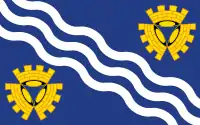 | 1 April 1974 to 31 March 1986 | Former Merseyside Council flag | The waves represent the River Mersey; the six golden mural crowns represent the six County Boroughs—Birkenhead, Bootle, Liverpool, Southport, St Helens, and Wallasey—that Merseyside was created from.. |
 | Flag of Norfolk Council | The top part of the flag, shows a lion from the Royal arms of England together with ostrich plumes and coronet referring to the Prince of Wales. This is a very special honour for the County Council, the King, in the Royal Licence, specifically instructs on the design of the arms to be granted "in commemoration of our long residence in Norfolk". This of course refers to Sandringham. The lower part of the flag comprises the arms attributed to Ralph de Gael or Guader, first Earl of Norfolk circa 1069. The ermine may well refer to Brittany as Ralph was Lord of Gael in that Duchy. | |
 | 7th century (modern form 1951) | Flag of Northumberland | Historical flag readopted in 1951 and used officially by the county council, and later released by the council and registered as the flag of the historic county. Eight yellow rectangles on a red field, note that the canton (top corner nearest the flagpole) should be gold.[23] |
 | Flag of Nottinghamshire Council | Local authority flag. The wave is for River Trent and the oak tree for Sherwood Forest. | |
 | Flag of Rutland Council | Local authority flag. A green background strewn with golden acorns, surrounding a central golden horseshoe. | |
 | Flag of Somerset Council | Local authority flag. A red dragon on a yellow field, bearing a blue mace – a banner of the county arms.[41] | |
 | Logo flag of South Yorkshire Council | Former local authority flag. | |
 | Former South Yorkshire Council | Flag based on the council's arms. | |
 | Flag of Staffordshire Council | Local authority flag. All the devices on the flag come from arms of various Earls of Stafford. The red chevron on gold was the arms of the de Staffords. It is charged with the family's famous Stafford knot badge. The lion represents the authority of the council. | |
 | Flag of Suffolk Council | Local authority flag. Coat of arms of Suffolk on a gold background. The main charge in the arms is the sun rising over the sea. Suffolk is the most easterly county in England and thus the first to see the sun rise. The open crowns and crossed arrows refer to Bury St Edmunds and have been widely used in the arms of Suffolk towns and districts. | |
 | Flag of Surrey Council | Local authority flag. Divided into halves, blue and black, with two gold keys representing the Chertsey Abbey, a woolpack on blue and a sprig of oak on black. (a banner of the modern coat of arms of Surrey County Council). | |
 | Former Tyne and Wear Council flag | Former local authority flag. | |
 | Former West Midlands Council flag | Local authority flag. The flag has two dancetty barrulets interlaced to form a W and M representing the initials of "West Midlands". | |
 | 1889-1974 | Former and commercially available West Sussex Council flag | Blue and gold flag with six golden martlets. Old 1889-1974 West Sussex County Council flag.[42] |
.png.webp) | 2008-Present | West Sussex Council flag | A blue banner with 7 light blue wavy lines with the crowned coat of arms in the centre in white. [43] |
Districts, towns and cities
| Flag | Date | Use | Description |
|---|---|---|---|
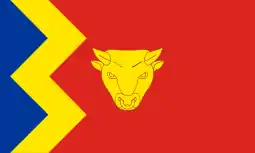 | 2015 | Flag of Birmingham (City and Metropolitan borough) | Golden vertical zig-zag offset to hoist dividing blue and red, with a bulls head in the centre. |
| [[File:|100x100px|border]] | 2014 | Flag of the Borough of Dacorum (District, Hertfordshire) | The lesser arms of the borough displayed on a green field. The Tudor Rose commemorating Berkhamsted's royal connections and King Henry VIII who granted the first charter to Hemel Hempstead, the Oak Leaves of Ashridge Woods commemorating the five councils which combined to form Dacorum: Berkhamsted Rural District Council, Berkhamsted Urban District Council, Hemel Hempstead Rural District Council, Hemel Hempstead Urban District Council, and Tring District Council |
 | Flag of the London Borough of Ealing (Greater London) | White with an oak tree standing on a green mound, the chief consists of three Saxon crowns on a red background. | |
 | Flag of the city of Durham (Civil parish, County Durham). | A red cross outlined in white on a black field. | |
 | Flag of the city of Leicester (City and unitary authority). | An ermine cinquefoil on a red background. | |
 | Flag of the city of Lincoln (City and Borough, Lincolnshire). | A red cross on a white field, charged with a gold fleur-de-lis. | |
 | Flag of the City of London (City and ceremonial county) | A red cross on a white field, with a red sword in the canton. This flag does not represent Greater London (which does not have its own flag, aside from the banner of the arms of the former Greater London Council), only the historical City of London which covers approximately 1 square mile (2.6 km2). | |
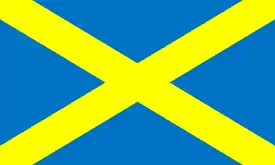 | Flag of the City and District of St Albans (District, Hertfordshire) | The Cross of St Alban – A gold saltire on a blue field. | |
 | Flag of Plymouth (City and unitary authority) | Banner of the arms of Plymouth City Council | |
 | Flag of the city of Portsmouth (City and unitary authority) | A crescent of gold on a shade of azure, with a blazing star of eight points. The flag is based on the official coat of arms granted to Portsmouth in 1194 by King Richard I to mark Portsmouth's newly granted market town status with a royal charter. Portsmouth's coat of arms were based on the coat of arms of Isaac Komnenos of Cyprus, whom Richard I had defeated in battle in during the Third Crusade of 1191. | |
 | Flag of the stannary town of Tavistock | A white field with a blue bend, defaced with the coat of arms. | |
 | Flag of York (City and unitary authority) | A red cross on a white field charged with five gold "leopards" (lions passant guardant). |
Regional flags
| Flag | Date | Use | Description |
|---|---|---|---|
 | 2012–present | Flag of the Black Country region. | Black and red field with white furnace and white and black chain. |
Anglo-Saxon kingdoms flags
| Flag | Date | Use | Description |
|---|---|---|---|
 | 1900s | Flag of East Anglia (Anglo-Saxon kingdom) reg | The arms ascribed to the Wuffingas dynasty of East Anglia, three crowns on a blue shield, superimposed on a St George's Cross, 3:5.[44] |
 | Ancient | Flag of Essex (Anglo-Saxon kingdom) reg | The flag of Essex is ancient in origin and features three Saxon seax (cutlasses) on a red field.[45] |
 | 1605 | Flag of Kent (Anglo-Saxon kingdom) reg | A red field with a white horse in the centre, 3:5.[46] |
.svg.png.webp) | 13th century | Flag of Mercia (Anglo-Saxon kingdom) | A gold saltire on a blue field (Cross of St Alban); the traditional flag of the Kingdom of Mercia, still flown on Tamworth Castle. |
 | 7th century | Flag of Northumbria (Anglo-Saxon kingdom) reg coa | The oldest flag in England. Flag of the greater region and former Kingdom of Northumbria. |
 | 5th century | Flag of Sussex (Anglo-Saxon kingdom) reg | Six gold martlets on a blue field. Officially adopted 20 May 2011 to represent the entire historical Kingdom of Sussex, 3:5. |
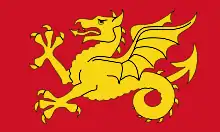 | 1974.[47] | Flag of Wessex (Anglo-Saxon kingdom) reg | A gold wyvern on a red field. Registered 20 May 2011. |
Historical flags
Royal standards
| Flag | Date | Use | Description |
|---|---|---|---|
 | 1198 – 1340 | Royal Banner of King Richard I | Gules three lions passant guardant in pale Or armed and langued Azure,[48][49] meaning three gold lions with blue tongues and claws, walking and facing the observer, arranged in a column on a red background. It forms the first and fourth quarters of the Royal Standard of the United Kingdom. |
.svg.png.webp) | 1340 – 1406 | Royal Banner of King Edward III | The Coat of Arms of England quartered with the Royal Standard of France, the fleurs-de-lis representing the English claim to the French throne. |
.svg.png.webp) | 1406 – 1603 | Royal Banner of King Henry IV | The French quartering has been altered to three fleurs-de-lis. |
.svg.png.webp) | 1603 – 1689, 1702 – 1707 | Royal Standard of the House of Stuart, used first by King James VI/I | A banner of the Royal Coat of Arms of James I, first and fourth quarters representing England and the English claim to the French throne, second quarter representing Scotland, third quarter representing Ireland. This was the last royal banner of the Kingdom of England. |
.svg.png.webp) | 1689–1702 | Royal Standard of King William III and II | A banner of the Royal Coat of Arms of William III, first and fourth quarters representing England and the English claim to the French throne, second quarter representing Scotland, third quarter representing Ireland, with an inescutcheon for the House of Nassau. |
National flags and ensigns
| Flag | Date | Use | Description |
|---|---|---|---|
 | Anglo-Saxon era | A dragon (known later in heraldry as a wyvern) which appears twice in the death scene of King Harold II on the Bayeux Tapestry depicting the Battle of Hastings in 1066. | |
 | 1620–1707 | English Red Ensign | Ensign of the red squadron with the Flag of England in the canton |
 | 1620–1702 | English White Ensign | Ensign of the white squadron with the Flag of England in the canton |
 | 1702–1707 | English White Ensign | Ensign of the white squadron with the Flag of England in the canton with large cross of St George placed upon a white background |
 | 1620–1707 | English Blue Ensign | Ensign of the blue squadron with the Flag of England in the canton |
.svg.png.webp) | 1606–1801 | First Union Jack/Flag of the United Kingdom of Great Britain | The first Union Flag (also known as the King's Colours) with the Cross of St George placed upon the Flag of Scotland |
Timeline
| Flag | Date | Use | Description | |
|---|---|---|---|---|
 | 519 – 927, 1135 – 1198 | Flag of Wessex. | . | |
 | 927 – 1066 | Flag Used For The Anglo-Saxons. | White Dragon Flag. | |
.svg.png.webp) | 1066 – 1135 | Banner of the Kingdom of France | ||
 | 1198 – 1340 | Royal Banner of King Richard I | Gules three lions passant guardant in pale Or armed and langued Azure,[48][49] meaning three gold lions with blue tongues and claws, walking and facing the observer, arranged in a column on a red background. It forms the first and fourth quarters of the Royal Standard of the United Kingdom. | |
.svg.png.webp) | 1340 – 1406 | Royal Banner of King Edward III | The Coat of Arms of England quartered with the Royal Standard of France, the fleurs-de-lis representing the English claim to the French throne. | |
.svg.png.webp) | 1406 – 1450 | Royal Banner of King Henry IV | The French quartering has been altered to three fleurs-de-lis. | |
 | 1450 – 1649 | St. George’s Cross | A Red Cross On A White Background. | |
.svg.png.webp) | 1649 – 1651 | A flag of the Commonwealth flown by the Admiral, Vice-Admiral, and Rear-Admiral. | On 5 March 1649 the Council ordered "that the Flagg that is to be borne by the Admiral, Vice-Admiral, and Rere-Admiral be that now presented, viz., the Armes of England [Red St. George Cross on white] and Ireland [gold harp on blue] in two severall Escotcheons in a Red Flag, within a compartment." | |
 | 1651 – 1652 | Flag of the Commonwealth from 1651 to 1658. | ||
.svg.png.webp) | 1652 – 1658 | Standard of the Lord Protector from 1655 to 1659. | ||
.svg.png.webp) | 1658 – 1660 | A flag used by the Commonwealth after 1658. | ||
 | 1660 - Present | Flag of England (also known as the St George's Cross) | A centred red cross on a white background, Flag of England | |
See also
Footnotes
- ^reg Registered at the Flag Institute.
- ^coa Designed by the College of Arms, the only legal body to grant official arms.
References
- "About Us". The College of Arms. Retrieved 22 December 2012.
The College is also the authority for matters relating to the flying of flags, and holds the only official registers of flags for the UK and much of the Commonwealth.
- "UK Flag Registry". The Flag Institute. Retrieved 22 December 2012.
- "Plain English guide to flying flags" (PDF). Department for Communities and Local Government. November 2012. Archived from the original (PDF) on 21 October 2013. Retrieved 22 December 2012.
- Flag of England
- Prothero, David (24 May 2004). "English Royal Standards, House of Tudor". www.crwflags.com. CRW Flags Inc. Retrieved 7 October 2018.
- Flag of Cornwall, traditional.
- Flag of Cumberland, traditional.
- Flag of Derbyshire, selected by public vote.
- Flag of Devon, selected by public vote.
- Flag of Dorset, selected by public vote.
- "County Durham flag with St Cuthbert's cross wins vote". BBC News. 21 November 2013. Retrieved 5 June 2016.
- Flag of Essex, traditional.
- Flag of Gloucestershire, selected by competition by the High Sheriff of Gloucester.
- [http://www.flaginstitute.org/wp/flags/Herefordshire/
- Flag of Hertfordshire, selected by local council.
- Flag of Kent, traditional.
- The Flag of Lancashire with a white field has been commonplace for many years. The change from a white to a yellow field was made at the request of the Flag Institute before registration, as the white field version is a banner of the arms of Montrose.
- Flag of Lancashire, selected by County Organisation.
- Flag of Lincolnshire, selected by public vote.
- Flag of Middlesex, based on former council's arms, from a traditional emblem.
- Flag of Norfolk, this design is the banner of the arms attributed to Ralph de Gael, first Earl of Norfolk.
- Flag of Northamptonshire, selected by public vote.
- Flag of Northumberland, selected by local Council.
- "Oxfordshire". UK Flag Registry. The Flag Institute.
- "Staffordshire County Flag Vote". The Flag Institute. 28 February 2016. Retrieved 5 June 2016.
- "Suffolk". The Flag Institute. Retrieved 10 December 2017.
- Strangeway, Andy (19 September 2014). "Surrey Flag". British County Flags. Retrieved 5 June 2016.
- https://sussexflag.wordpress.com/
- https://www.gov.uk/government/news/sussex-flag-flies-above-whitehall-to-mark-sussex-day
- "Worcestershire". The Flag Institute. Retrieved 5 June 2016.
- Flag of Yorkshire
- "Ceremonial and Historic county boundary data added to OS OpenData". www.ordnancesurvey.co.uk.
- "England - Geographic counties". Encyclopædia Britannica.
- of Isle of Portland
- https://www.flaginstitute.org/wp/flags/isle-of-purbeck-flag/
- Flag of Isles of Scilly, selected by public vote.
- "County Durham, England". Flags of the World. 2015. Retrieved 5 June 2016.
- https://sussexflag.wordpress.com/councilflags/
- "County Flag of Leicestershire". Leicestershire County Council. 8 March 2012. Retrieved 14 November 2012.
- "Newsletter (No. 3)". College of Arms. November 2004. Retrieved 5 June 2016.
- https://sussexflag.wordpress.com/councilflags/
- https://sussexflag.wordpress.com/councilflags/
- Flag of East Anglia, traditional.
- Flag of Essex, traditional.
- Flag of Kent, traditional.
- https://www.flaginstitute.org/wp/flags/wesse/
- Fox-Davies 2008, p. 607.
- "Coat of Arms of King George III". The First Foot Guards. Retrieved 4 February 2010.


